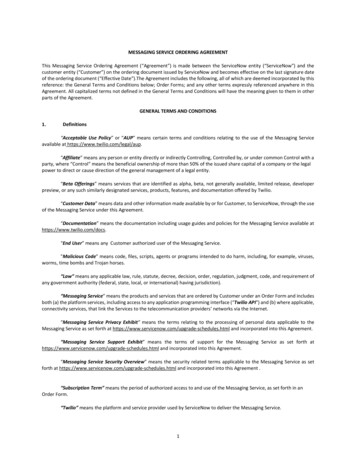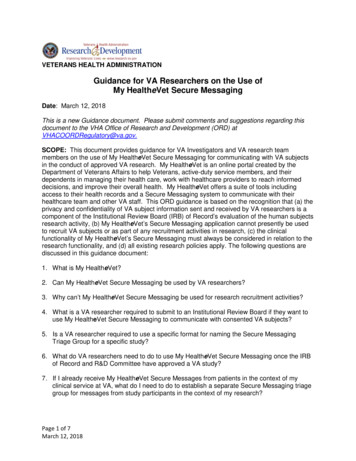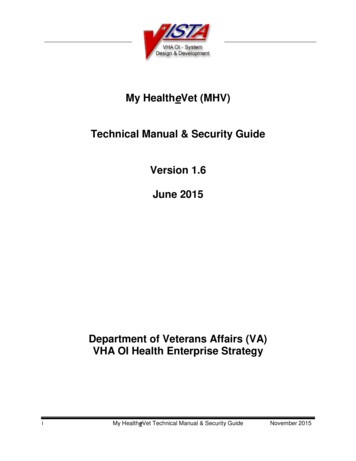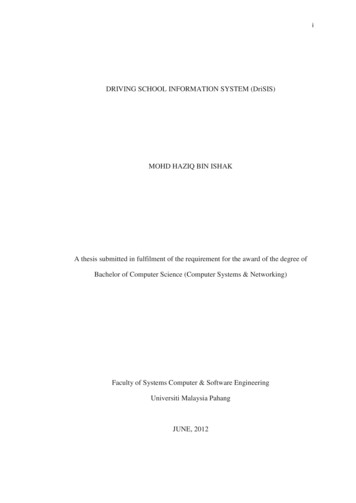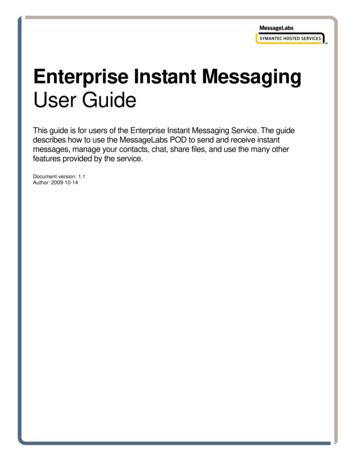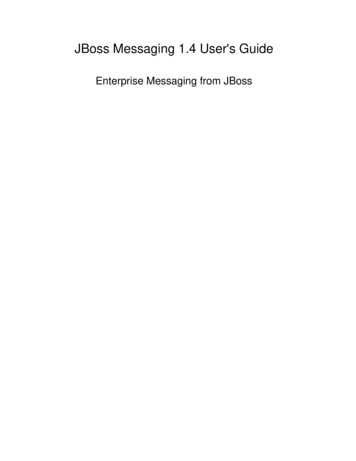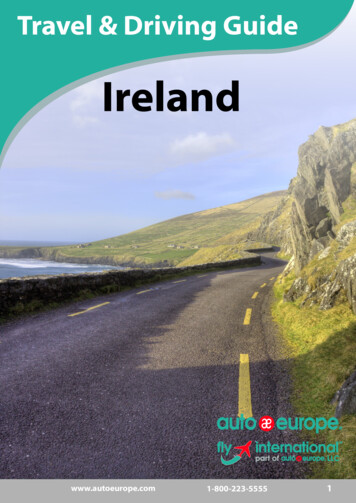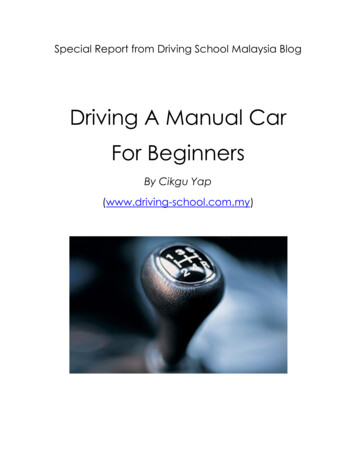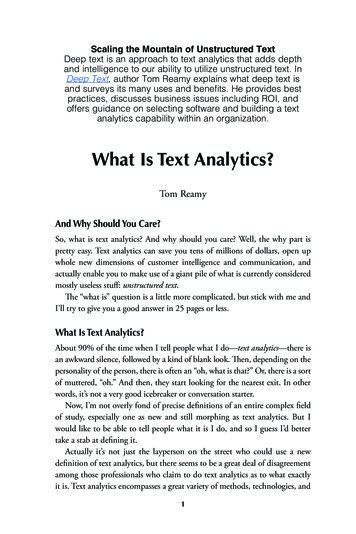
Transcription
Human Factors: The Journal of the Human Factors and Ergonomics Society OnlineFirst, published on December 16, 2009 asdoi:10.1177/0018720809353319Text Messaging During Simulated DrivingFrank A. Drews, Hina Yazdani, Celeste N. Godfrey, Joel M. Cooper,and David L. Strayer, University of Utah, Salt Lake CityObjective: This research aims to identify the impact of text messaging on simulateddriving performance. Background: In the past decade, a number of on-road, epidemiological, and simulator-based studies reported the negative impact of talking on a cellphone on driving behavior. However, the impact of text messaging on simulated drivingperformance is still not fully understood. Method: Forty participants engaged in botha single task (driving) and a dual task (driving and text messaging) in a high-fidelitydriving simulator. Results: Analysis of driving performance revealed that participantsin the dual-task condition responded more slowly to the onset of braking lights andshowed impairments in forward and lateral control compared with a driving-only condition. Moreover, text-messaging drivers were involved in more crashes than drivers notengaged in text messaging. Conclusion: Text messaging while driving has a negativeimpact on simulated driving performance. This negative impact appears to exceed theimpact of conversing on a cell phone while driving. Application: The results increase ourunderstanding of driver distraction and have potential implications for public safety anddevice development.INTRODUCTIONIn recent years, a noticeable shift in potentially distracting activities of drivers has takenplace. In the past, drivers often engaged inmore traditional distracting activities, such asconsuming beverages or food. However, withthe availability of mobile technologies, suchas cellular phones, global positioning systems,and entertainment systems, additional sourcesof distraction are readily available and widelyused by drivers. The present article focuses onone of these technologies: the cellular phone.In their seminal study, Redelmeier andTibshirani (1997) evaluated the cell phonerecords of 699 individuals who were involved inmotor vehicle crashes during a 14-month timeperiod. The authors found that almost a quarterof these individuals used their cellular phone inthe 10 min preceding the crash and that usinga cell phone while driving was associated witha fourfold increase in the likelihood of beinginvolved in a crash (see also Violanti, 1998).Strayer and Johnston (2001) demonstratedin a series of studies that participants engagedin cell phone conversations were more likelyto miss traffic signals and reacted to the signals that they did detect more slowly than driverswho were not conversing on cell phones. Thiswork also demonstrated that there was no difference between use of handheld and hands-freecell phones in terms of their impact on drivingperformance (see also McEvoy et al., 2005). Bycontrast, listening to radio broadcasts or bookson tape did not impair driving performance.Additional research explored the mechanismsleading to the impairments observed in cellphone drivers. Strayer, Drews, and Johnson(2003) demonstrated that drivers conversingon a cell phone show signs of inattention blindness, processing up to 50% less of the information in their environment than a driver who isnot engaged in a cell phone conversation (seealso Strayer & Drews, 2007).However, not all types of conversations havethe same influence on driving performance, aswas recently demonstrated by Drews, Pasupathi,and Strayer (2008). Drews and his collaboratorsdemonstrated that there is a difference betweenAddress correspondence to Frank Drews, University of Utah, Psychology, 390S 1530E BEH RM 502, Salt LakeCity, Utah 84112; drews@psych.utah.edu. HUMAN FACTORS, Vol. X, No. X, Month XXXX, pp. xxx-xxx.DOI: 10.1177/0018720809353319. Copyright 2009, Human Factors and Ergonomics Society.
2passenger conversations and cell phone conversations, wherein passenger conversations, unlikecell phone conversations, do not impair drivingperformance.Overall, there is little doubt that conversingon a cell phone significantly degrades drivingperformance (Drews & Strayer, 2008; but seeShinar, Tractinsky, & Compton, 2004). However,with the emergence of text messaging, another,potentially more dangerous source of distractionemerged. With the increasing availability of textmessaging in newer generations of cell phones,the frequency of this activity has skyrocketed.For example, according to a survey conductedby Telstra in Australia (Telstra, 2003), 30% ofthe respondents admitted to having sent textmessages while driving a vehicle, and almost20% regularly send text messages while driving. Text messaging is increasingly popular inthe United States and worldwide. According to asurvey conducted by CTIA in 2005, there were 81billion text messages sent in the United States;however, in 2008, the number of send text messages exceeded 1 trillion (CTIA, 2009).One likely reason for the popularity of text messaging is related to human factors improvementsin the interface, resulting in the emergence ofsimpler and potentially more convenient methods of text entry (most recently, full text entry).One development for text entry is the “text onnine keys” (T9) predictive text entry system. T9entry uses a large dictionary to disambiguate anentry according to the most likely intention towrite the current entry, on the basis of previous input. The system uses the nine numericalkeys of a cell phone that have assigned three tofour different letters to them. The older multitapmode (Alpha mode) uses the same number ofkeys, but here a letter is entered by pressing akey repeatedly (e.g., for entering the letter s, the7 key has to be pushed four times. Because ofa reduction of required key taps, the T9 entrysystem allows users to enter text about twiceas fast as did the Alpha mode. The T9 systemfacilitates the entry of text messages; however,the cognitive effort associated with receivingand processing of text messages is not affectedby this development.Regan, Young, Lee, and Gordon (2008) provided a similar distinction of activities involvedMonth XXXX - Human Factorsin interacting with a cell phone by conductinga task analysis of steps involved in talking on acell phone. Drawing from Wickens and Horrey’s(2008) model, Regan et al. quantified the impactof individual actions on driving performance.According to Regan et al., manual entry of information (dialing a number) has the most negativeimpact on driving performance. Thus, even withimprovements in text entry technology, there isgood reason to hypothesize that text messaging,with its repeated text entry, should negativelyaffect driving performance. Additional support for this hypothesis comes from studies thatfocused on the interaction with other nomadicdevices while driving. These studies, whichoften investigated the biomechanical aspects ofdriver distraction, indicate that manipulation ofnavigation systems (Tsimhoni, Smith, & Green,2004), DVD players (Hatfield & Chamberlain,2005), and radios (Horberry, Anderson, Regan,Triggs, & Brown, 2006; Wikman, Nieminen,& Sumala, 1998) result in negative changesof driving behavior. Such changes manifest inincreases in lane position deviations, reductionin driving speeds, and, often, changes in glancebehavior, for example, more time with eyesspent off road (for a review, see Bayly, Young,& Regan, 2008).A different prediction on the impact of textmessaging on driving performance can be madeon the basis of the asynchronous nature of textmessaging. As Jamson, Westerman, Hockey,and Carsten (2004) pointed out, the locus of control of text messaging compared with talking ona cell phone while operating a motor vehicle isdriver controlled; that is, the driver can choosewhen to enter a text message, whereas a drivertalking on a cell phone is more pressured into“maintaining a particular pace of response” (p.626). This situation provides drivers with thepossibility of choosing times of relatively littledemand of the driving task (little surrounding,smooth flowing traffic) for text messaging. Theconsequence might be that that driving performance is affected only minimally and potentialchanges in performance show only during shortperiods of text messaging. Thus, the potentialimpact of text messaging may show a differentpattern than the impact of conversing on a cellphone: During an exchange of text messages,
Text Messagingthere might be times when a driver is waiting for a message, allowing focusing on driving, whereas at other times, text message entrymight negatively affect driving performance.Unfortunately, there is only very little empirical work on text messaging while driving.One of the few studies was done by Hosking,Young, and Regan (2009), who examined theimpact of text messaging on driving performance by recording eye movements in a highfidelity driving simulator. In Hosking et al.’sstudy, 20 young, novice drivers (less than 6months of driving experience) were exposedto a number of safety-related events (e.g., apedestrian appears from behind a car) during adriving task, which also included car followingand lane changing. Both activities of retrievingand sending text messages negatively affecteddriving performance. For example, the driver’sability to control lateral vehicle position andresponses to traffic signs were significantlyimpaired during the messaging activity. Also,during this activity, the driver’s eyes focusedless often on the road compared with the control condition. However, the driving speed ofthe distracted drivers did not differ from theirspeed in the control condition, although thefollowing distance increased. The increasein following distance was interpreted by theauthors as an example of the drivers’ attempting to compensate for the increased distractionwhile driving. Overall, the changes in drivingperformance are similar to the findings in thecontext of cell phone conversations while driving (i.e., changes on the operational and tactical levels; Drews et al., 2008).Similarly, Kircher et al. (2004) focusedon receiving text messages while driving in asimulator. Ten experienced drivers receivedtext messages while driving in the simulator.Participants were instructed to retrieve the messages and to respond to them verbally. Effectson driving behavior were measured in terms oftime for braking onset. While participants werereading text messages, the braking times weresignificantly longer and drivers drove slowerthan in baseline driving conditions.One question that is still unanswered isrelated to the issue of the impact of text messaging on driving performance and accidentrates. As outlined earlier, there are different3predictions that can be made on the impact oftext messaging while driving. Given the taskanalysis performed by Regan et al. (2008), textmessaging should result in a significant reduction in driving performance. Another reason forsuch a prediction is that text messaging not onlyrequires central attentional processing but alsorequires additional focusing on the phone duringthe process of composing or reading messages.Therefore, it is likely that the impairments associated with text messaging while driving will becomparable to or even higher than those foundwhen drivers converse on cell phones, given theincrease in processing demands.Alternatively, it is possible that because textmessaging is a more internally controlled task,drivers may strategically chose times of low taskdemand associated with the driving task to perform text entries, resulting in little or no impacton overall driving performance.The current research pursues two objectives:First, the study seeks to establish the impact oftext messaging in simulated driving on drivingperformance and safety, therefore replicating andextending the findings of Hosking et al. (2009).Second, this research aims to estimate the impactof text messaging during simulated driving onaccident rates and, furthermore, the reason forany observed impairments in driver performance.In particular, we hypothesize that the dual-taskcombination of driving and text messaging mayplace additional demands on visual attention thatresult in participants’ switching attention betweenactivities rather than simultaneously sharingattention between the two tasks.METHODParticipantsParticipants in this study were 40 youngadults ranging in age from 19 to 23 years; 21 yearswas the average age. Among the participants,20 were women and 20 were men. All participants had normal or corrected-to-normal visualacuity, normal color vision (Ishihara, 1993),and a valid, nonprobationary driver’s license.Participants had an average of 4.75 years of driving experience (range 3 to 7 years). Participantswere recruited in a total of 20 friend dyads(i.e., participants’ friends who have knowneach other for more than 1 year) and received
4course credit for participation. On the basis ofquestionnaire data collected at the beginningof the study, the participants can be consideredexperienced in sending text messages. In thequestionnaire, 90% responded that they sendtext messages more than three times a day ona regular basis. All participants responded thatthey would either likely or surely read a textmessage received while driving a vehicle. Thelarge majority of participants (90%) respondedthat they send text messages while driving morethan once a week.Stimuli and ApparatusA PatrolSim mid- to high-fidelity drivingsimulator, manufactured by L3 CommunicationsI-Sim, was used in the present study. The simulated vehicle is based on the vehicle dynamicsof a Crown Victoria model with automatic transmission built by the Ford Motor Company. Thesimulator consists of three screens providing afront view and two side views to the driver (thevisual field is approximately 180 ) and includesrear view and side view mirrors. The simulatoruses a fixed base, that is, it does not simulatemotion of a real vehicle.To evaluate driving performance, a freewayroad that simulated a 32-mile multilane ruraland urban beltway with on and off ramps, overpasses, and two- and three-lane traffic in eachdirection was used. A pace car, programmedto travel in the right-hand lane, braked intermittently throughout the scenario. Twenty-twodistracter vehicles were programmed to drivebetween 5% and 10% faster than the pace car inthe left lane. This manipulation produced theimpression of a traffic flow of varying densityin the left-hand lane, creating times of higherand lower demand on the driver. Two drivingscenarios (one requiring driving in the oppositedirection of the other), counterbalanced acrossparticipants and experimental condition, wereused in the study. Measures of real-time drivingperformance, including distance from othervehicles, brake inputs, and steering inputs, weresampled at 60 Hz and stored for later analysis.Because familiarity with a particular modelof cell phone can potentially have an impact ontext messaging performance, participants usedtheir own cell phones to send and receive textMonth XXXX - Human Factorsmessages in this study, as they are highly familiar with the user interface implemented in theircellular phone and the way text messages aredisplayed and text is entered. Baseline performance for text messaging indicated that participants took an average of 57 s (SD 21) to enterthe following pangram: “The quick brown foxjumps over the lazy dog.” All participants usedT9 for text entry.ProcedureThe experiment was conducted in a singlesession. After participants answered a seriesof questionnaires concerning the frequency oftext messaging while driving, the dyad receivedinstructions about the text-messaging task, whichconsisted of exchanging text messages with thegoal to plan an evening activity together. Forthis purpose, the nondriving member of the dyadwas provided with information about potentialactivities, such as the movie theater, concert,and sports programs and a number of restaurants. One participant of the dyad was randomlyselected to drive the simulator vehicle while theother member sent messages containing information related to available evening activities to thedriver. The driver was instructed to drive safelyand to follow all the traffic rules. In addition, inthe dual-task condition, drivers were instructedto exchange text messages with the goal of planning an evening activity together. Following thisinstruction, the designated driver was familiarized with the driving simulator using a standardized adaptation sequence, reported in moredetail elsewhere (Drews et al., 2008).Each driving participant was tested in abaseline driving condition, a text-messagingand-driving condition, and a baseline textmessaging condition (with the last condition toassure that participants were fluent in text message entry). The order of the conditions wascounterbalanced across participants. Duringdriving, the participant’s task was to follow thepace car driving in the right-hand lane of thehighway. In each scenario, the pace car was programmed to brake at 42 randomly selected intervals and would continue to decelerate until theparticipant depressed the brake pedal, at whichpoint the pace car would begin to accelerate tonormal freeway speeds. If the participant failed
Text Messaging5to depress the brake, he or she would eventually collide with the pace car. The brake lightsof the pace car were illuminated throughout thedeceleration interval. Thus, each scenario provided 42 opportunities to measure participants’response to the lead vehicle’s braking in frontof them. Participants in the dual-task conditionreceived and composed text messages whileoperating the vehicle. Because they used theirown cellular phones, the messages were displayed on the specific model’s display. Also,participants needed to manually manipulatetheir cell phones while receiving and composing messages, which was in almost all casesdone by holding the cell phone up with the righthand at the height of the steering wheel.RESULTSThe results for the driving performance measures are shown in Table 1. We performed theanalyses using a repeated-measurement ANOVAwith driving condition as a repeated measurement factor.TABLE 1: Means and Standard Deviations of DrivingPerformance for Each Experimental ConditionConditionVariableBrake onset time (ms)Following distance (m)Standard deviation offollowing distance (m)Minimal followingdistance (m)Lane crossings (perkilometer)Lane reversals (perkilometer)Gross lateraldisplacement (m)SingleTaskDualTask88.1 (349)29.1 (9.7)11.9 (6.3)1,0.77 (380)34.3 (12.6)17.9 (9.5)9.0 (3.0)6.8 (2.3)0.26 (0.3)0.49 (0.5)10.5 (4.4)13.2 (4.1)4.3 (1.3)5.4 (1.9)Brake Onset TimeThe first ANOVA analyzed the brake onsettime for participants in both conditions. Theresults of the analysis indicated a significanteffect of condition, F(1, 19) 12.5, p .01. Asshown in Table 1, participants were 0.2 s slowerin responding to the brake onset when drivingand text messaging compared with the singletask, driving-only condition. A more detailedanalysis of the braking reaction time focused onvincentized cumulative distribution functions(CDFs) for each condition, which are presentedin Figure 1. In the figure, the reaction time ateach decile of the distribution is plotted, andit is evident that the dual-task CDF is systematically displaced to the right, indicating slowerreactions compared with those in the single-taskcondition. To quantify the differences betweenboth conditions, we performed a series of t testsfor each decile comparing the single- and thedual-task conditions. The results of this analysis indicated that the dual-task performancediffered from single-task performance for alldeciles except the first: t-values for the each ofthe deciles, t(19) –1.7, p .1; t(19) –2.1,p .05; t(19) –3.5, p .01; t(19) –3.6, p Figure 1. Binned reaction times for single- and dualtask conditions.01; t(19) –3.1, p .01; t(19) –4.7, p .01;t(19) –4.5, p .01; t(19) –4.3, p .01;t(19) –4.3, p .01; t(19) –3.8, p .01.The next analysis focused on the specificactivities involved in text messaging following the task analytic approach of Regan et al.(2008). For this purpose, video-based coding ofthree text-messaging activities at the time thelead vehicle was braking was performed: Thefirst activity involves entering a message (meanfrequency 14; SD 6.2), the second activityinvolved receiving and reading a text message
6(mean frequency 1.2; SD 1.2), and the thirdactivity included times when participants werenot engaged in either of the two activities (i.e.,participants were driving but not interactingwith the cell phone; mean frequency 15.7;SD 8.0). Table 2 provides the average reactiontimes to the onset of a braking light for eachactivity. A repeated-measure ANOVA revealeda significant effect of activity, F(2, 10) 20.4,p .01. Post hoc tests indicated significant fasterreaction times for driving only compared withentering, t(17) 4.5 , p .01, and receiving andreading, t(11) 4.7, p .01, but no significantdifference between entering and reading of textmessages, t(11) 1.975, p .074.Following DistanceThe average following distance for the singletask and for the dual-task condition is presentedin Table 1. The ANOVA for average followingdistance revealed that the difference betweenthe single-task condition and the dual-task condition was significant, F(1, 19) 16.4, p .01.Similar to the data on cell phone use while driving (see Strayer et al., 2003), participants whowere text messaging while driving increasedthe following distance to the lead vehicle. Inaddition, an ANOVA for the standard deviationof following distance was also significant, F(1,19) 18.4, indicating that when participantstexted with their friends, they exhibited significantly increased variability in car-followingbehavior. An ANOVA of the minimum following distance in single- and dual-task conditionsalso found significantly smaller minimum following distance in the dual-task condition, F(1,19) 7.5, p .05, as shown in Table 1. Thus,text-messaging drivers increased their following distance (on average), exhibited greaterfollowing distance variability, and showed asmaller minimum following distance than didthe drivers in the single-task condition. Overall,text messaging while driving caused a morevaried following distance profile than did thedriving-only condition.Lane MaintenanceAn ANOVA of lane crossings found that textmessaging drivers exhibited more instances ofinadvertent lane departures compared withMonth XXXX - Human FactorsTABLE 2: Means and Standard Deviations ofObservations and of Reaction Times for Activities inthe Text Messaging ConditionDual ervations1.2 (1.2)14.0 (6.2) 15.7 (8.0)perparticipantBrake onset 1,645 (140) 1,301 (158) 973 (63)time (ms)drivers in the single-task condition, F(1, 19) 5.38, p .05. Texting drivers also displayed agreater number of lane position reversals, that is,a change of the direction of lateral vehicle heading from drifting left to drifting right, F(1, 19) 15.2, p .01. This higher frequency of lane position reversals is analogous to the often-reportedfinding that secondary task distraction increasessteering reversals (Knappe, Keinath, Bengler, &Meinecke, 2007; McLean & Hoffmann; 1975).Finally, an ANOVA of gross lateral displacement compared the total lateral distance traveled between single- and dual-task conditionsand found a significant effect of text messaging,F(1, 19) 7.19, p .05.Combined with the analysis of vehiclefollowing characteristics, these findings suggestthat text messaging impairs both forward andlateral vehicle control.CollisionsThe final analysis examined the number ofvehicle collisions in the present study. Weobserved a total of seven collisions that werecaused by individual participants (each collision was caused by a different participant).It is noteworthy that six (86%) of the crashesoccurred in the dual-task condition, that is,while participants were text messaging whileoperating the vehicle. Only one accidentoccurred in the single-task driving condition. Acomparison of accident rates in both conditionsusing a one-sided McNemar c2 test revealeda significant difference (c2 4.33, p .05) incrash rates, reflecting the sixfold increase of
Text Messaging7crashes when participants were text messagingwhile driving.DISCUSSIONOverall, an intriguing picture emerged as aresult of this simulator study that allows characterizing the influence of text messaging on driving performance.One of the observations is that text-messagingdrivers substantially increase their average following distance to a lead vehicle. This behaviorhas been interpreted as an attempt by drivers toreduce the likelihood of getting into a crash (e.g.,Strayer et al., 2003). Thus, it is possible that textmessaging drivers may be aware of the increasein risk associated with text messaging (seeAmerican Automobile Association, 2007, fordata on teenagers), and they either consciouslyor unconsciously compensate for this increaseby creating a “safety buffer.” However, giventhe increase in crash risk, the strategy of creatingsuch a safety buffer appears to be inadequate.To further explore why driving while textmessaging is impaired to such an extent, wereturn to our analysis of the reaction time distributions (cf. Figure 1). By computing the ratioof dual-task reaction time to single-task reactiontime at each decile, we can provide an estimate ofthe relative costs of text messaging. In Figure 2,the resulting dual-task/single-task reaction timeratio is plotted. For comparison purposes, wehave plotted the dual-task/single-task reactiontime ratios for hands-free and handheld cellphone conversations from Cooper and Strayer(2008; see also Strayer, Crouch, & Drews, 2006).The 40 participants from this study aresimilar to the current participants in age (average 23 years) and driving experience (7 yearswith a driver’s license). Also, the driving scenarios are identical in terms of traffic densityand task difficulty. The data compared hereare the aggregated data of the specific experimental conditions (i.e., individual activities arenot analyzed). In Figure 2, a ratio of 1.0 wouldindicate no impairment to reaction time. It isevident that all activities involving the concurrent use of a cell phone increase the dual-task/single-task ratio. Interestingly, the functionsfor handheld and hands-free cell phone conversations are relatively vertical, indicating aFigure 2. Dual-task/single-task ratio for three differentexperimental conditions.systematic shift in the reaction time distribution by about 10% (but only a modest changein the shape of the distribution, which suggeststhat the combined distributions are similar). Bycontrast, text messaging clearly has the highestdual-task/single-task ratio, and the differencegrows rather strikingly across the deciles ofthe distribution. This increase suggests that theratios result from a combination of two distributions (e.g., normal and exponential distribution)into an ex-Gaussian distribution.Indeed, the pattern observed with text messaging suggests a dual-task cost in reaction timethat results from two processes, with a smaller15% cost in the lower deciles of the distribution and a much greater 30% to 45% cost at thehigher deciles. The interpretation of a differential dual-task cost receives additional supportfrom the analysis of specific activities involvedin text messaging. In the text-messaging condition, participants displayed no impairmentduring the times when not interacting with theircell phone, t(18) 1.1, p .1, but clear impairments in driving performance when interactingwith their cell phone.The observed performance in the dual-taskcondition could be accomplished through eithera sharing of attentional resources between theconcurrent tasks or a switching of attentionbetween the two tasks. Interestingly, the dualtask/single-task ratios suggest different patternsof attentional strategies for cell phone conversations and text messaging. Conversing on acell phone appears to be more consistent with
8a sharing model of attention, albeit one that issubject to the response selection bottlenecklimitations described by Pashler and colleagues(e.g., Levy, Pashler, & Boer (2006); Levy &Pashler, 2008; see also Wickens’s [1984] multiple resources model). That is, drivers apparentlyattempt to divide attention between a phone conversation and driving, adjusting the processingpriority of the two activities depending on taskdemands. By contrast, text messaging appearsto be most consistent with a switching model ofattention, in which attention is allocated in largepart either to driving or to text messaging. Whendrivers have switched their attention to the textmessaging task, that is, composing or readingor receiving a message, their reaction times tobraking events are substantially higher, reflecting a substantial cost of task switching.The observed changes in reaction timedepending on text-messaging task are of interest in this context: Both reading and composingaffect reaction times, and a statistical trend indicated that braking times increased more whenparticipants were reading messages. However, itseems too early to draw conclusions based onthis trend because of the relative small samplesize. If future studies indicate that reading textmessages produces larger impairments, then thisfinding would have important practical implications for in-vehicle technology. For example,systems reading messages out loud could support drivers (Tsimhoni, Green, & Lai, 2001).However, if the impairment associated withreading text messages is a result of the externallycontrolled event of receiving a text message,then suppressing reception of messages whileoperating a vehicle might be a better-suited strategy to mitigate the impact of driver distraction.T
Text Messaging During Simulated Driving Frank A. Drews, Hina Yazdani, Celeste N. Godfrey, Joel M. Cooper, and David L. Strayer, University of Utah, Salt Lake City Objective: This research aims to identify the impact of text messaging on simulated driving performance. Background: In the past decade, a number of on-road, epidemio- logical, and simulator-based studies reported the negative impact .

